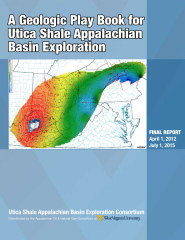Driven in part by production from Marcellus Shale and other shale plays, natural gas has surpassed coal as the leading source of our nation’s electricity, and now a West Virginia University study suggests there’s more to come underneath the Marcellus.
Results of the study provide evidence that the Utica play, which spans West Virginia, Pennsylvania, Kentucky, Ohio and New York, is much larger than original estimates, and its size and potential recoverable resources are comparable to the Marcellus play, the largest shale oil and gas play in the U.S. and the second largest in the world.
Data from Utica Shale Play Book Study, a two-year geological study conducted by the Appalachian Oil and Natural Gas Research Consortium, a program of the National Research Center for Coal and Energy at WVU, were presented at a workshop today (July 14) in Canonsburg, Pennsylvania.
The majority of the Utica Shale play lies beneath the Marcellus Shale play. The interval between the two plays – the space between the Marcellus and the deeper Utica – ranges from 4,000 feet in Ohio to greater than 6,500 feet in West Virginia. The drilling depth of the Utica ranges from less than 4,000 feet in Ohio to more than 12,000 feet in West Virginia, which is more than two miles below the surface.
In 2013, a study by the U.S. Energy Information Administration, reported that Marcellus Shale operators produced 2.86 trillion cubic feet of gas. In a 2012 study, the U.S. Geological Survey estimated that technically recoverable resources in the Utica – the volume that can be extracted from the reservoir using existing technology – were 38 trillion cubic feet of gas and an additional 940 million barrels of oil.
WVU’s study shows that the Utica play contains technically recoverable resources of 782 Tcf of gas and 1,960 MMbo.
“The revised resource numbers are impressive, comparable to the numbers for the more established Marcellus Shale play, and a little surprising based on our Utica estimates of just a year ago which were lower,” said Douglas Patchen, director of the consortium and well-known expert on the Appalachian Basin.
“But this is why we continued to work on the resource estimates after the project officially ended a year ago. The more wells that are drilled, the more the play area may expand, and another year of production from the wells enables researchers to make better estimates.”
The project was the brainchild of Patchen and had three main objectives:
- Assess the geological characteristics of Utica and equivalent rocks in the northern Appalachian basin
- Define Utica oil and gas fairways
- Provide resource assessments
Patchen said that the general public may only be interested in the resource numbers, but the research consortium wanted to undertake a multi-disciplinary, basin-wide project at various scales.
“Our research spanned basin-wide subsurface correlation and mapping of potential pay zones to macroscopic and microscopic examination of cores and thin sections of reservoirs to the nano-scale development of porosity in organic rich zones,” he said.
In addition to estimates of oil and gas resources, the research team presented comprehensive data on the stratigraphy, petrology, reservoirs and areal distribution of the play. Researchers found that:
- The play is actually neither “Utica” nor “shale” and data point to an interbedded limestone and organic-rich shale interval in the underlying Point Pleasant Formation as the preferred drilling target;
- The most productive hydrocarbon source rocks tend to be the Point Pleasant Formation and the upper and Logana members of the Lexington/Trenton Formation;
- The combination of a relatively shallow reservoir and the potential for liquids production make Utica an attractive play for producers;
- Original gas-in-place – the amount of hydrocarbon store in the reservoir prior to production – is approximately 3,192 Tcf and original oil-in-place is approximately 82,903 MMbo; and
- It is expected that given current technology the play-wide oil recovery factor will be approximately 3% and the gas recovery factor will be approximately 28% in the “sweet spot” areas.
“This is a landmark study that demonstrates the vast potential of the Utica as a resource to complement – and go beyond – what the Marcellus has already proven to be,” said Brian Anderson, director of WVU’s Energy Institute. “Dr. Patchen and his team are to be commended for assembling an impressive consortium to undertake such a comprehensive study such as this.”
The consortium is a partnership of 15 industry members, four state geological surveys, two universities, one consulting company, and one national lab. Members include the WVU National Research Center for Coal and Energy, Washington University, the Kentucky Geological Survey, the Ohio Geological Survey, the Pennsylvania Geological Survey, the West Virginia Geological and Economic Survey, the U.S. Geological Survey, Smith Stratigraphic, and the U.S. Department of Energy National Energy Technology Laboratory.
The consortium was sponsored by Anadarko, Chevron, CNX, ConocoPhillips, Devon, EnerVest, EOG Resources, EQT, Hess, NETL Strategic Center for Natural Gas and Oil, Range Resources, Seneca Resources, Shell, Southwestern Energy and Tracker Resources.
-WVU-
ms/07/14/15
CONTACT: Tracy Novak; National Research Center for Coal and Energy
304.293.6928; Tracy.Novak@mail.wvu.edu
Follow @WVUToday on Twitter.
